初中一般现在时、一般过去时、现在完成时表格
- 格式:doc
- 大小:32.00 KB
- 文档页数:1
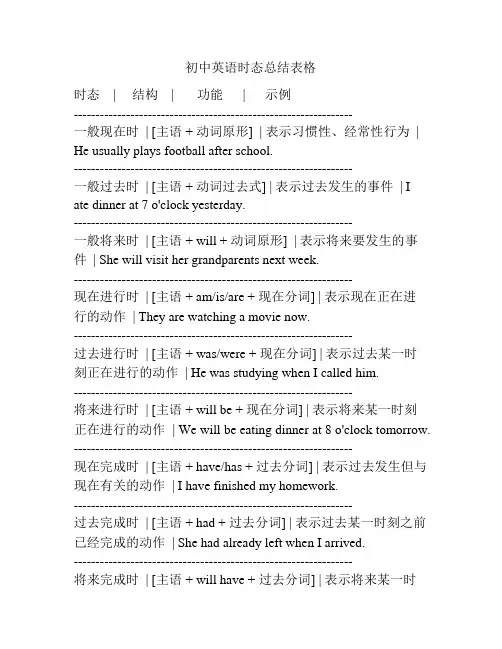
初中英语时态总结表格时态 | 结构 | 功能 | 示例----------------------------------------------------------------一般现在时 | [主语 + 动词原形] | 表示习惯性、经常性行为 | He usually plays football after school.----------------------------------------------------------------一般过去时 | [主语 + 动词过去式] | 表示过去发生的事件 | I ate dinner at 7 o'clock yesterday.----------------------------------------------------------------一般将来时 | [主语 + will + 动词原形] | 表示将来要发生的事件 | She will visit her grandparents next week.----------------------------------------------------------------现在进行时 | [主语 + am/is/are + 现在分词] | 表示现在正在进行的动作 | They are watching a movie now.----------------------------------------------------------------过去进行时 | [主语 + was/were + 现在分词] | 表示过去某一时刻正在进行的动作 | He was studying when I called him.----------------------------------------------------------------将来进行时 | [主语 + will be + 现在分词] | 表示将来某一时刻正在进行的动作 | We will be eating dinner at 8 o'clock tomorrow. ----------------------------------------------------------------现在完成时 | [主语 + have/has + 过去分词] | 表示过去发生但与现在有关的动作 | I have finished my homework.----------------------------------------------------------------过去完成时 | [主语 + had + 过去分词] | 表示过去某一时刻之前已经完成的动作 | She had already left when I arrived.----------------------------------------------------------------将来完成时 | [主语 + will have + 过去分词] | 表示将来某一时刻之前已经完成的动作 | By this time next year, we will have graduated from high school.----------------------------------------------------------------情态动词 | [情态动词 + 动词原形] | 表示能力、意愿、推测等 | She can swim very well.----------------------------------------------------------------。
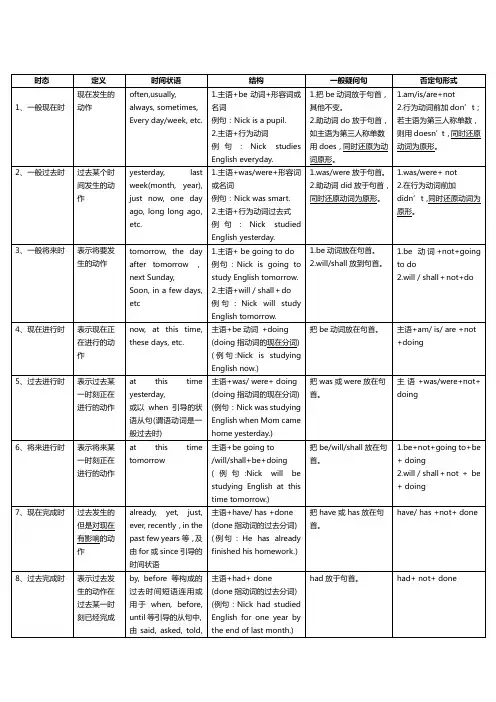
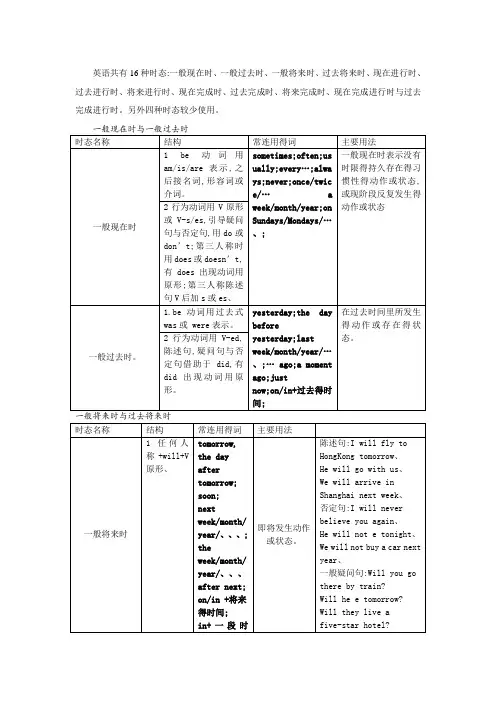
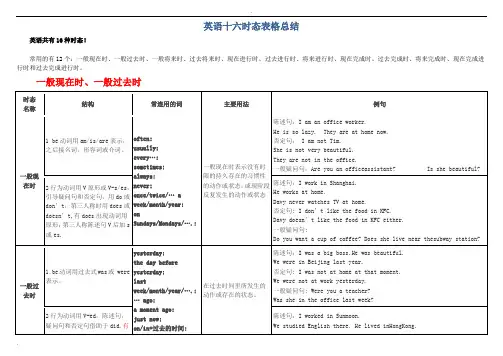
英语十六时态表格总结英语共有16种时态!常用的有12个:一般现在时、一般过去时、一般将来时、过去将来时、现在进行时、过去进行时、将来进行时、现在完成时、过去完成时、将来完成时、现在完成进行时和过去完成进行时。
一般现在时、一般过去时时态名称结构常连用的词主要用法例句一般现在时1 be动词用am/is/are表示,之后接名词,形容词或介词。
often;usually;every…;sometimes;always;never;once/twice/… aweek/month/year;onSundays/Mondays/….;一般现在时表示没有时限的持久存在的习惯性的动作或状态,或现阶段反复发生的动作或状态陈述句:I am an office worker.He is so lazy. They are at home now.否定句: I am not Tim.She is not very beautiful.They are not in the office.一般疑问句:Are you an officeassistant? Is she beautiful? 2行为动词用V原形或V-s/es,引导疑问句和否定句,用do或don’t;第三人称时用does或doesn’t,有does出现动词用原形;第三人称陈述句V后加s或es.陈述句:I work in Shanghai.He works at home.Davy never watches TV at home.否定句: I don’t like the food in KFC.Davy doesn’t like the food in KFC either.一般疑问句:Do you want a cup of coffee? Does she live near thesubway station?一般过去时1.be动词用过去式was或 were表示。
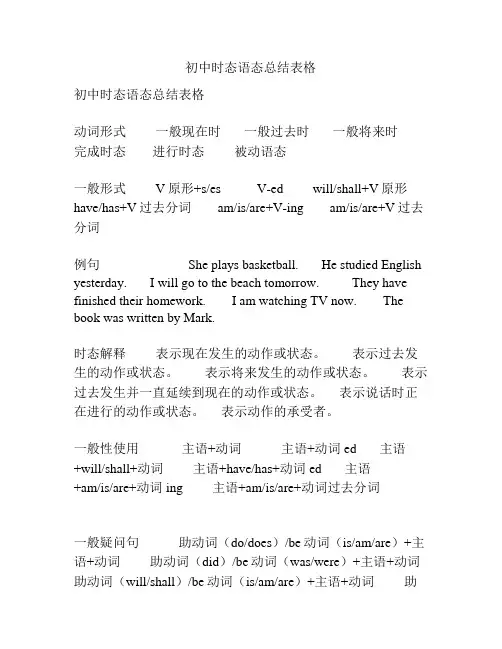
初中时态语态总结表格初中时态语态总结表格动词形式一般现在时一般过去时一般将来时完成时态进行时态被动语态一般形式 V原形+s/es V-ed will/shall+V原形have/has+V过去分词 am/is/are+V-ing am/is/are+V过去分词例句 She plays basketball. He studied English yesterday. I will go to the beach tomorrow. They have finished their homework. I am watching TV now. The book was written by Mark.时态解释表示现在发生的动作或状态。
表示过去发生的动作或状态。
表示将来发生的动作或状态。
表示过去发生并一直延续到现在的动作或状态。
表示说话时正在进行的动作或状态。
表示动作的承受者。
一般性使用主语+动词主语+动词ed 主语+will/shall+动词主语+have/has+动词ed 主语+am/is/are+动词ing 主语+am/is/are+动词过去分词一般疑问句助动词(do/does)/be动词(is/am/are)+主语+动词助动词(did)/be动词(was/were)+主语+动词助动词(will/shall)/be动词(is/am/are)+主语+动词助动词(have/has)/be动词(is/am/are)+主语+动词ed 助动词(am/is/are)/be动词(is/am/are)+主语+ 动词ing 助动词(am/is/are)/be动词(is/am/are)+主语+动词过去分词特殊疑问句疑问词+助动词(do/does)/be动词(is/am/are)+主语+动词疑问词+助动词(did)/be动词(was/were)+主语+动词疑问词+助动词(will/shall)/be 动词(is/am/are)+主语+动词疑问词+助动词(have/has)/be动词(is/am/are)+主语+动词ed 疑问词+助动词(am/is/are)/be动词(is/am/are)+主语+ 动词ing 疑问词+助动词(am/is/are)/be动词(is/am/are)+主语+动词过去分词否定句主语+助动词(do not/does not)/be动词(is/am/are not)+动词主语+助动词(did not)/be动词(was/were not)+动词主语+助动词(will/shall not)/be动词(is/am/are not)+动词主语+助动词(have/has not)/be 动词(is/am/are not)+动词ed 主语+助动词(am not/is not/are not)/be动词(is/am/are not)+动词ing 主语+助动词(am not/is not/are not)/be动词(is/am/are not)+动词过去分词情态动词主语+情态动词+动词原形主语+情态动词+动词原形主语+will/shall+情态动词+动词原形主语+have/has+情态动词+动词原形主语+am/is/are+情态动词+ 动词ing 主语+am/is/are+情态动词+动词过去分词现在进行时主语+am/is/are+V-ing 主语+was/were+V-ing 主语+will/shall+be+V-ing 主语+have/has+been+V-ing - -过去进行时主语+was/were+V-ing -- - - -将来进行时主语+will/shall+be+V-ing -- - - -完成进行时主语+have/has+been+V-ing 主语+had+been+V-ing - -- -被动语态主语+am/is/are+V过去分词主语+was/were+V过去分词主语+will/shall+be+V过去分词主语+have/has+been+V过去分词主语+am/is/are+being+V过去分词主语+am/is/are+V过去分词。
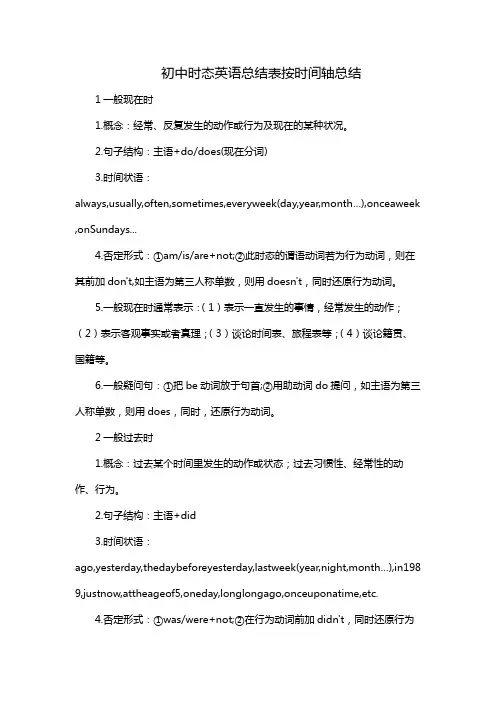
初中时态英语总结表按时间轴总结1一般现在时1.概念:经常、反复发生的动作或行为及现在的某种状况。
2.句子结构:主语+do/does(现在分词)3.时间状语:always,usually,often,sometimes,everyweek(day,year,month…),onceaweek ,onSundays...4.否定形式:①am/is/are+not;②此时态的谓语动词若为行为动词,则在其前加don't,如主语为第三人称单数,则用doesn't,同时还原行为动词。
5.一般现在时通常表示:(1)表示一直发生的事情,经常发生的动作;(2)表示客观事实或者真理;(3)谈论时间表、旅程表等;(4)谈论籍贯、国籍等。
6.一般疑问句:①把be动词放于句首;②用助动词do提问,如主语为第三人称单数,则用does,同时,还原行为动词。
2一般过去时1.概念:过去某个时间里发生的动作或状态;过去习惯性、经常性的动作、行为。
2.句子结构:主语+did3.时间状语:ago,yesterday,thedaybeforeyesterday,lastweek(year,night,month…),in198 9,justnow,attheageof5,oneday,longlongago,onceuponatime,etc.4.否定形式:①was/were+not;②在行为动词前加didn't,同时还原行为动词。
5.一般疑问句:①was或were放于句首;②用助动词do的过去式did提问,同时还原行为动词。
3现在完成时1.概念:过去发生或已经完成的动作对现在造成的影响或结果,或从过去已经开始,持续到现在的动作或状态。
2.句子结构:have/has+done3.时间状语:recently,lately,since…for…,inthepastfewyears,etc.4.否定形式:have/has+not+done.5.一般疑问句:have或has。
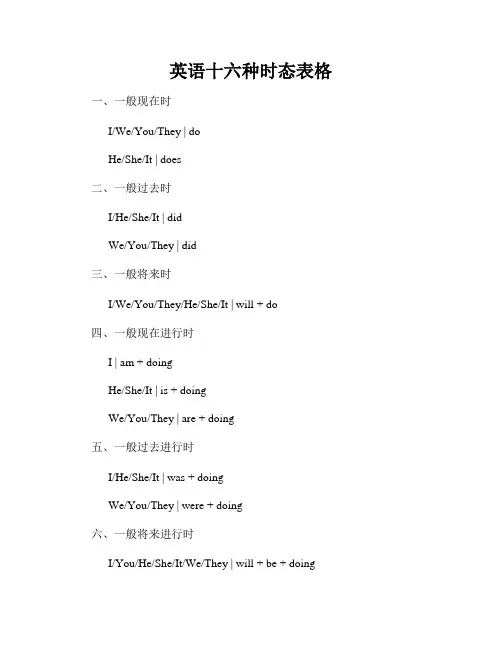
英语十六种时态表格一、一般现在时I/We/You/They | doHe/She/It | does二、一般过去时I/He/She/It | didWe/You/They | did三、一般将来时I/We/You/They/He/She/It | will + do四、一般现在进行时I | am + doingHe/She/It | is + doingWe/You/They | are + doing五、一般过去进行时I/He/She/It | was + doingWe/You/They | were + doing六、一般将来进行时I/You/He/She/It/We/They | will + be + doing七、一般现在完成时I/You/We/They/He/She/It | have/has + done八、一般过去完成时I/You/We/They/He/She/It | had + done九、一般将来完成时I/You/We/They/He/She/It | will have + done十、现在完成进行时I/You/We/They/He/She/It | have/has been + doing 十一、过去完成进行时I/You/We/They/He/She/It | had been + doing十二、将来完成进行时I/You/We/They/He/She/It | will have been + doing 十三、现在完成时I/You/We/They/He/She/It | have/has + done十四、过去完成时I/You/We/They/He/She/It | had + done十五、将来完成时I/You/We/They/He/She/It | will have + done十六、过去将来时I/You/He/She/It/We/They | would + do以上是英语中的十六种时态及其对应的动词形式。
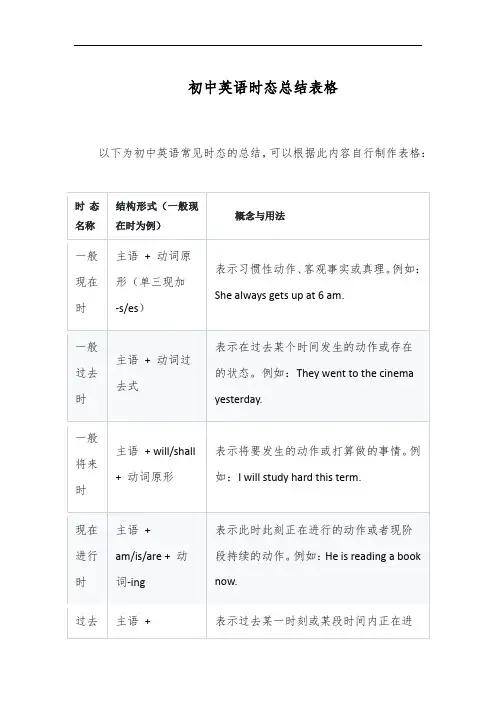
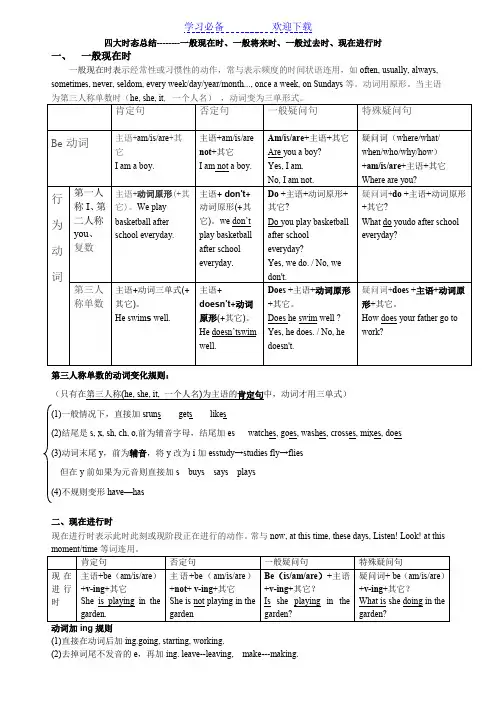
四大时态总结--------一般现在时、一般将来时、一般过去时、现在进行时一、一般现在时一般现在时表示经常性或习惯性的动作,常与表示频度的时间状语连用,如often, usually, always, sometimes, never, seldom, every week/day/year/month..., once a week, on Sundays等。
动词用原形。
当主语第三人称单数的动词变化规则:(只有在第三人称(he, she, it, 一个人名)为主语的肯定句中,动词才用三单式)(1)一般情况下,直接加sruns gets likes(2)结尾是s, x, sh, ch, o,前为辅音字母,结尾加es watches, goes, washes, crosses, mixes, does(3)动词末尾y,前为辅音,将y改为i加esstudy→studies fly→flies但在y前如果为元音则直接加s buys says plays(4)不规则变形have—has二、现在进行时现在进行时表示此时此刻或现阶段正在进行的动作。
常与now, at this time, these days, Listen! Look! at this动词加ing规则(1)直接在动词后加ing.going, starting, working.(2)去掉词尾不发音的e,再加ing. leave--leaving, make---making.注意:如果单词结尾的e发音,则不能去掉,也直接加ing. see –seeingagree - agreeing .(3) 对于动词只有一个元音,而其后跟了一个辅音字母时,双写末尾辅音字母再加ing.sitting, beginningrun – runningstop – stoppingcut – cuttingcontrol – controlling(4)以ie结尾,把ie变y再加ing。
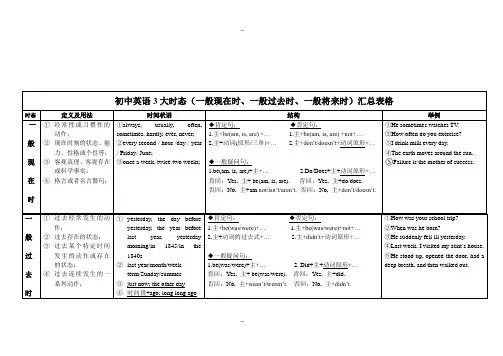
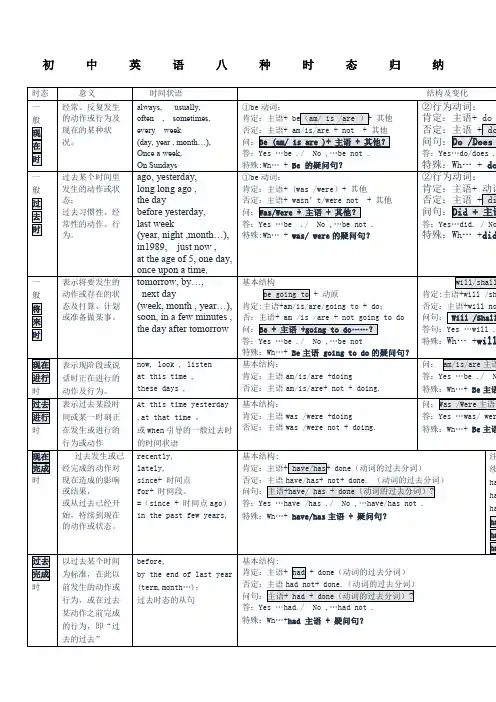
英语16种时态表格总结各时态结构及具体用法:1.一般现在时(do/does; is/am/are)①表示现在的情况、状态和特征。
例:He is a student.他是一个学生。
②表示经常性、习惯性动作。
例:He always helps others.他总是帮助别人。
③客观事实和普遍真理。
例:The earth moves the sun.地球绕着太阳转。
④表示一个按规定、计划或安排要发生的动作。
(常用于列车、客车、飞机或轮船时刻表)例:The next train leaves at 3 o'clock this afternoon.下一趟火车今天下午3点开车。
⑤主将从现:在时间、条件和让步状语从句中经常用一般现在表示将的来事情。
例:If it rains tomorrow, we will stay at home.如果明天下雨,我们会待在家里。
2.现在进行时(am/is/are doing)①表示此时此刻正在发生的事情。
例:He is listning to the music now.他现在正在听音乐。
②表示目前一段时间内一直在做的事情,但不一定此时此刻正在做。
例:I am studying computer this term.这个学期我一直在学习计算机。
③现在进行时可以表示将来的含义。
瞬时动词的进行一定表将来。
例:I am leaving.我要离开了。
持续动词的进行只有有将来的时间状语或有将来语境中才表将来。
例:I am travelling next month.下个月我要去旅行。
④现在进行时与频度副词连用,表示说话者或褒义或贬义的感情色彩。
例:He is always helping others.他总是帮助别人。
(褒义)3.过去进行时(was/ were doing)①表示在过去一个具体的时间正在发生的动作。
例:Mary was listening to light music 10 minutes ago.10分钟前,玛丽正在听轻音乐。
初中常用的有8种时态:一般现在时,一般过去时,一般将来时,现在进行时,过去进行时,现在完成时,过去完成时和过去将来时,其他时态在初中少见(一)一般现在时的定义:一般现在时是表示现在经常反复发生的动作存在的状态或习惯性的动作的时态.一般现在时的构成:(这是一个简单的表格)动词肯定句否定句Iam...Iamnot...beYou/We/TheyareYou/We/TheyarenotHe/She/ItisHe/She/Itisnot一般现在时用行为动词的原形,主语是he,she,it这些第三人称单数时,动词要加s 或es.(二)一般过去时的定义:一般过去时是表示过去经常或偶然发生的动作或存在的状态的时态.一般过去时的构成:动词肯定句否定句Iwas...Iwasnot...beHe/She/Itwas...He/She/Itwasnot...We/You/Theywere...We/You/Theywerenot...一般过去时用动词的过去式动词的过去式一般都加ed,如workworked.结尾是e的只加d,如likeliked.末尾只有一个辅音字母的重读闭音节要双写这个字母再加ed,如stops topped,以辅音字母加y结尾的,先变y为i再加ed,如studystudied.另外还有一些不规则的变化,课本后边的单词表上有注释.(三)一般将来时的定义:一般将来时是表示将来发生的动作或存在的状态的时态.一般将来时的构成:人称肯定句否定句一I/Wewillgo.I/Wewillnotgo.二Youwillgo.Youwillnotgo.三He/She/It/Theywillgo.He/She/Theywillnotgo一般将来时由助动词(will,shall)+动词原形构成,shall主要用于以第一人称(I,We)为主语的疑问句中.(四)现在进行时的定义:现在进行时是表示在某一时刻或某段时间正在进行的动作的时态.现在进行时的构成:现在进行时由系动词(am,is,are)+现在分词(动词加ing形式)构成.如Iamworking.AmIworking?Iamnotworking.(五)过去进行时的定义:过去进行时是表示在过去某一时刻或某段时间内正在进行的动作时态.过去进行时的构成:过去进行时是由系动词的过去式(waswere)+现在分词(动词加ing)构成的.如Iwastalking,WasItalking?Iwasnottalking.(六)现在完成时的定义:现在完成时是表示在过去发生但与现在情况有联系的动作或状态的时态.现在完成时的构成:现在完成时是由助动词have,has+过去分词构成的,过去分词的变化方法和上述的过去式的方法一样,在此不做详细解释.过去分词也有不规则的.如Youhavetalked.Haveyoutalked?(七)过去完成时的定义:过去完成时表示在过去某一时间或动作以前已完成的行为或存在的状态.过去完成时的构成:过去完成时由助动词had(无人称和数的变化)+过去分词构成,其否定句式和疑问句式在结构上与现在完成时一样.如They/hehadreadit.Hadthey/hereadit?(八)过去将来时的定义:过去将来时表示从过去的观点看将来发生的动作或存在的状态.过去将来是的构成:过去将来时由助动词would+动词原形构成.如Hesaidhewouldcome.主要用于下面几情况:1) 描述当前时间内经常出现、反复发生的动作或存在的状态。
八大时态的结构表英语的八大时态有:一般现在时(主语+do/does)、一般过去时(主语+did)、一般将来时、现在进行时、过去进行时、过去将来时、现在完成时和过去完成时。
一、一般现在时:主语+do/does(现在分词)基本结构:①动词原形②主语第三人称单数:动词原形+s/es三种常考基本用法:1、经常性和习惯性动作2、客观事实和普遍真理3、在时间状语从句及条件状语从句中,一般现在表将来常见时间状语:always, usually, often, sometimes, every day, on Sundays, at weekends, once a week, twice a month, etc.二、一般过去时:主语+did基本结构:动词的过去式基本用法:1、过去某个时间里发生的动作或状态2、过去习惯性、经常性的动作常见时间状语:ago, yesterday, the day before yesterday, last week (year, night, month), in 1986, just now, at the age of 10, at that time, once upona time, etc.三、一般将来时:will do/基本结构:①am/is/are/going to + do;②will/shall + do.基本用法:1、(人)计划打算做某事2、(事)即将发生will/shall do1、将来的动作和状态(相对较长远)2、礼貌询问、客气邀请3、意愿常见时间状语:tomorrow, next day (week, month, year), soon, the day after tomorrow, in+时间段(格外注意),etc.四、现在进行时:主语+am/is/are doing基本结构:am/is/are+现在分词基本用法:1、此时此刻正在进行的动作2、现阶段正在进行的动作常见时间状语:now, at this time, these days, etc.五、过去进行时:was/were doing基本结构:was/were+现在分词基本用法:1、过去某时刻正在进行的动作2、过去某时段正在进行的动作常见时间状语:at this time yesterday, at that time或以when引导的谓语动词是一般过去时的时间状语等.六、过去将来时:was/were to /would do基本结构:①was/were/going to + do;②would/should + do.基本用法:从过去时间点看将来,常用于宾语从句中.常见时间状语:the next day (morning, year), the following month (week), etc.七、现在完成时:have/has done基本结构:have/has + 过去分词基本用法:1、过去发生的动作对现在造成的影响或结果2、过去已经开始,持续到现在的动作或状态常见时间状语:recently, lately, so far, up to now, since+时间点,for+时间段, in the past few years, etc.八、过去完成时:had done基本结构:had + 过去分词基本用法:以过去某个时间为标准,在此以前发生的动作或行为,即过去的过去.常见时间状语:before, after, by the end of last year(month),etc.。
英语十六时态表格总结英语共有16种时态!常用的有12个:一般现在时、一般过去时、一般将来时、过去将来时、现在进行时、过去进行时、将来进行时、现在完成时、过去完成时、将来完成时、现在完成进行时和过去完成进行时。
一般现在时、一般过去时时态名称结构常连用的词主要用法例句一般现在时1 be动词用am/is/are表示,之后接名词,形容词或介词。
often;usually;every…;sometimes;always;never;once/twice/… aweek/month/year;onSundays/Mondays/….;一般现在时表示没有时限的持久存在的习惯性的动作或状态,或现阶段反复发生的动作或状态陈述句:I am an office worker.He is so lazy. They are at home now.否定句: I am not Tim.She is not very beautiful.They are not in the office.一般疑问句:Are you an officeassistant? Is she beautiful? 2行为动词用V原形或V-s/es,引导疑问句和否定句,用do或don’t;第三人称时用does或doesn’t,有does出现动词用原形;第三人称陈述句V后加s或es.陈述句:I work in Shanghai.He works at home.Davy never watches TV at home.否定句: I don’t like the food in KFC.Davy doesn’t like the food in KFC either.一般疑问句:Do you want a cup of coffee? Does she live near thesubway station?一般过去时1.be动词用过去式was或 were表示。
初中英语时态一览表以下是初中英语主要时态的一览表:1. 现在一般时:I eat an apple every day.2. 过去一般时:She studied English last year.3. 现在进行时:They are playing basketball now.4. 过去进行时:They were having dinner at this time yesterday.5. 现在完成时:I have finished my homework.6. 过去完成时:They had learned 2000 English words by the end of last year.7. 现在完成进行时:We have been waiting for you for half an hour.8. 过去完成进行时:We had been learning English for 3 years by the end of last year.9. 将来一般时:She will visit her grandparents next week.10. 将来进行时:They will be having a meeting tomorrow.11. 将来完成时:They will have finished their work by the end of this week.12. 过去将来一般时:He said he would go to the library the next day.13. 过去将来进行时:He said he would be working on his project over the weekend.14. 过去将来完成时:He said he would have written the report by the end of the month.希望这个一览表能帮到你!如果你还有其他问题,请随时提问。
以下是初中英语语法八大时态总结表格:时态用法构成时间状语一般现在时表示经常发生的动作或存在的状态主语+动词原形/第三人称单数形式+其他always, usually, often,sometimes, everyday/week/month/year, etc.一般过去时表示过去发生的动作或存在的状态主语+动词过去式+其他yesterday, lastweek/month/year, etc.现在进行时表示现在正在进行的动作主语+am/is/are+现在分词+其他now, at the moment, etc.过去进行时表示过去某个时刻正在进行的动作主语+was/were+现在分词+其他at this time yesterday,etc.一般将来时表示将要发生的动作或存在的状态主语+will/shall+动词原形+其他tomorrow, nextweek/month/year, etc.过去将来时表示过去将要发生的动作或存在的状态主语+would/should+动词原形+其他the next day, etc.时态用法构成时间状语现在完成时表示过去发生的动作对现在造成的影响或结果主语+have/has+过去分词+其他already, yet, ever, never,for/since, etc.过去完成时表示过去某个时间之前已经完成的动作主语+had+过去分词+其他by the time, before, etc.需要注意的是,这些时态的构成和用法可能会有一些例外情况,具体取决于语境和句子结构。
此外,不同的教材和地区可能会有一些差异,因此在学习过程中,建议你参考多种资料,以便更好地理解和掌握这些时态。